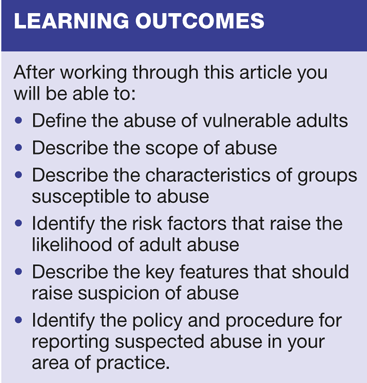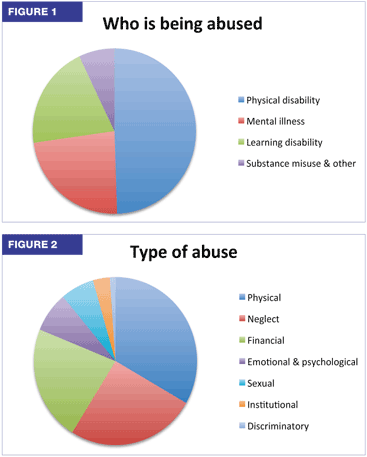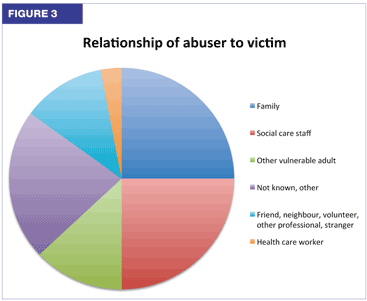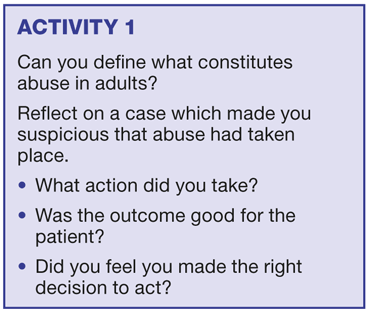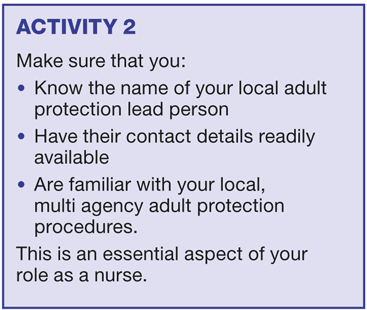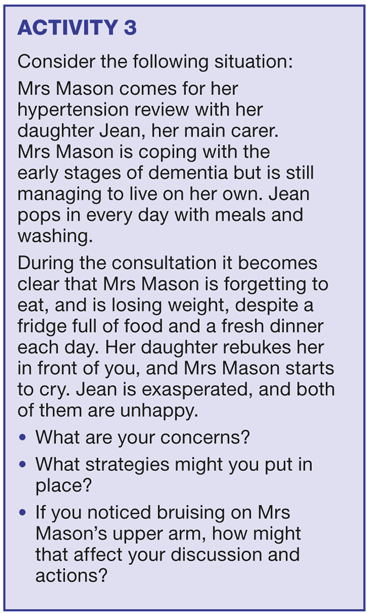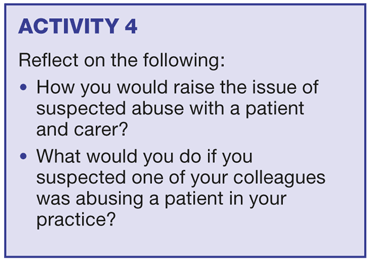Why safeguarding adults matters
Deborah Sturdy RN Msc (Econ)
Deborah Sturdy RN Msc (Econ)
Independent Consultant
Honorary lecturer, City University London
The abuse of vulnerable adults has attracted much less attention than child abuse, but is no less important. Practice nurses have an important role to play in both recognising the potential for abuse and preventing it, and in detecting abuse at an early stage and initiating appropriate actions to stop it.
The focus on child abuse has absorbed much media coverage. Individual cases have provoked horror and revulsion and have led to government action and legislative processes aimed at safeguarding young people in society. The implicit ageism of this focus on children could, however, be said to overshadow the importance of and greater vulnerability of older people. Inequality in the approach to safeguarding individuals at either end of the age spectrum is itself a demonstration of inequity and age discrimination and, some may say, an institutional abuse. Safeguarding adults, while it has been much debated, remains not wholly understood and is a largely unrecognised and unacknowledged phenomenon. There is considerable stigma attached to the subject, it is complex and great delicacy is needed in negotiating the processes of assessment and evidence gathering. The safeguarding of vulnerable adults should be an acknowledged priority of nursing practice, yet it is one of the taboo areas of nursing and care.
In the last decade there has been increasing interest in the development of national policy for adult safeguarding, both in terms of individuals and institutions. The administrations of all the countries making up the United Kingdom have taken a responsible and proactive approach to increasing awareness of abuse and setting in place a policy response for local implementation.
The understanding of policy and procedure, together with a sensitive approach when handling a suspected case of abuse, are needed to ensure a swift and appropriate response.
DEFINING ABUSE
The fact that adult abuse is complex has created a number of challenges in agreeing definitions of what it constitutes. It takes place in a multiplicity of settings: the person's own home, the hospital, in care homes, social services and GP surgery. The perpetrators of abuse can be anyone who comes in contact with the vulnerable person. In addition, vulnerable adult populations form a diverse group with different, often complex, needs. The victims of adult abuse are a far from homogenous group and include older adults, people with learning disabilities, sufferers from mental health problems, and those with physical disability.
The Department of Health (DH) defines a vulnerable adult as:
Someone over the age of 18 years old who may be in need of community care services by reason of mental or other disability, age or illness, and who is or may be unable to take care of him or herself, or unable to protect him or herself against significant harm or exploitation.1
The DH also use the universally accepted definition of abuse:
The violation of an individual's human and civil rights by any other person or persons1
It can take place in any context and is an abuse of authority and power that has a negative impact on the individual's well-being, health and safety. It includes:
- Sexual abuse
- Financial and material abuse
- Psychological abuse
- Neglect or omission
- Institutional abuse
- Physical abuse.
SCOPE OF ABUSE
The numbers of people experiencing abuse are unknown, though estimates suggest that up to half a million older people are subjected to abuse at any time.2 An increased awareness of adult abuse and a need to gain a real sense of the amount and type of abuse that was occurring prompted the government to order the collation and publication of national data sets. Since 2010 local safeguarding teams have been required to submit records of abuse. The first national report, from 2010-11,3 has recently been published, and it has provided a mine of valuable information that should enable us to consider the issues and incidence of abuse, and the circumstances in which it occurred, in a more informed way.
It appears that women are more at risk of abuse than men and older adults more at risk than younger people. This first report found that 62% of the referrals were for women and 61% were for older adults aged 65 and over. Almost half of the referrals (49%) were for adults with a physical disability, 23% were for mental health clients, 20% were for learning disabled clients and the remaining 7 per cent were for adults with a substance misuse problem or other vulnerable adults.3 (Figure 1)
Physical abuse was the most common type of abuse reported, accounting for 30% of all allegations. This was followed by neglect (23%) and financial abuse (20%). Sixteen per cent of referrals were related to emotional or psychological abuse, followed by sexual (6%), institutional (3%) and discriminatory (1%). (Figure 2)
Vulnerable adults were more likely to be abused in their own home (accounting for 41% of all locations cited) or a care home (34%) than in any other setting.
The person causing harm to the vulnerable adult was most likely to be a family member (25% of all perpetrators) or social care staff (25%). Thirteen per cent of the alleged abusers were other vulnerable adults, 12% were recorded as either a friend or neighbour, volunteer, other professional or a stranger, and 3% were health care workers. The remaining 22% of relationships to the victim were recorded as either 'Not Known' or 'Other'. (Figure 3)
THE NURSE'S ROLE
The opening statement of the Nursing and Midwifery Council's code of conduct states that:
The people in your care must be able to trust you with their health and well-being4
To fulfil this duty, all nurses need to be aware of the potential for abuse of any vulnerable adult they come into contact with during their practice.
Nurses, including practice nurses, are often the first professional with whom an individual has physical contact and are often the first point of contact for the person subjected to abuse. It is therefore vital that all nurses are able to recognise the presenting features of abuse, have minds that are open to suspicions of it and, when their suspicions are raised, be ready to take on the role of first line responder with the knowledge, ability and courage to take the initial, appropriate actions to deal with it.
There are a number of key actions that you should be able to take:5
1. As a registered nurse you have a responsibility to:
- Act appropriately in safeguarding vulnerable adults
- Be aware of your local adult protection policies and procedures and clear about your own role within these
- Know who is the lead person in your service for adult protection and how to contact him or her.
2. In your work area you should:
- Ensure that leaflets on how service users, carers and families can identify and report abuse are accessible.
- Ensure that the name and contact details for your local adult protection lead person are available, along with your up to date local multi agency adult protection procedures.
- Consider systematically reviewing your work practices to ensure that inadequate care is swiftly identified and effectively modified.
3. In your practice you should:
- Seek feedback on your work from colleagues and service users, along with appropriate supervision and mentorship
- Maintain your clinical and professional competence and strive to give the highest standards of care based on best evidence
- Keep up to date by reading nursing journals and seek any training or updating you need
- Ultimately be vigilant about identifying any aspects of your own practice, and that of your colleagues, that could potentially result in a violation of an individual's human and civil rights.1
RECOGNITION OF ABUSE
We know that abuse most commonly takes place in the person's own home and is perpetrated by someone they know. The role of carer and the burden of care have the potential to impact on the health and well-being of the individual carer, and on the person being cared for. The family focus of general practice means that practice nurses are often well placed to recognise when carers are under strain. You are in an ideal position to instigate strategies to support and enhance the carer's role and to take action to prevent or reduce the potential for abuse occurring. Carer assessment, i.e. routine review of the carer's needs and their relationship with the vulnerable adult, is key in preventing crises and deterioration in the relationship between the carer and the cared for person.
Some of the key features of abuse and risk factors for it that should alert you to become concerned or extra vigilant include:5
- Frequent minor injuries, such as bruises, abrasions, welts or other unexplained marks
- Unexplained bruising, particularly in well protected areas, or burns in unusual places
- Situations where the explanation does not correlate with the injury
- Families where there is a history of mental ill health or alcohol dependency
- A vulnerable adult with high dependency needs
- A socially isolated and/or stressed carer caring for a highly dependent adult
- Excessive repeat prescriptions, indicating over use of medication
- Poor living conditions and low income
- A carer who appears to resent the person, is angry or frustrated and has a sense of loss of their own ambitions
- A carer who is defensive and wants to accompany the person at all times
- The carer avoids contact with the GP and practice.
These indicators will help in providing a mental checklist when assessing the risk factors for carer and cared for.
Time is of the essence in recognising both abuse and the potential for abuse. The relationship between nurse and carer, and nurse and patient is critical for supporting the process of intervention and solution of actual or suspected abuse. As a nurse you have a duty to ensure that you are safeguarding the interests of patients and protecting the public. You need to know about and be able to easily access the accountability framework and local procedure for raising alerts about safeguarding issues, so that the response to any concerns raised is swift. Clear information, such as the contact details of the Adult Safeguarding lead and where to go for advice from local sources of expertise needs to be readily available on site in the practice.
No one should underestimate the resolve needed to follow through what can be a difficult and distressing situation and any individual reporting actual or suspected abuse will need the support of colleagues during the referral and review process. The local Safeguarding Team are the best first point of contact and will provide confidential advice and support to the individual, and guidance and expert knowledge to the health team.
CONCLUSION
Recognising abuse is complex. Nurses need to be vigilant in order to detect the potential signs and subtle observations that will alert them to actual or potential abuse. Practice nurses have a critical role to play, not only in the protection of the person who is being abused, but also in recognising the stress and burden of carers. You have an important role in early intervention to reduce carer burden and avert abuse.
To take no action if you suspect abuse is to condone it, and to jeopardise your position in terms of professional accountability. Seeking timely and appropriate advice from local experts, and ensuring support for yourself during the process of investigation and resolution of suspected abuse is key. If, as nurses, we are unaware of abuse, do not recognise its existence and do not acquire the necessary skills that will allow its early detection we will be in breach of the NMC Code of Conduct and will be unable to prevent some of society's most vulnerable people from becoming victims.
REFERENCES
1. Department of Health and Home Office. No secrets: guidance on developing and implementing multi-agency policies and procedures to protect vulnerable adults from abuse. 2000. http://www.dh.gov.uk/en/Publicationsandstatistics/Publications/PublicationsPolicyAndGuidance/DH_40084862. House of Commons Health Committee. Elder abuse. Second report of session 2003-4 http://www.publications.parliament.uk/pa/cm200304/cmselect/cmhealth/111/111.pdf 3. The Health and Social Care Information Centre. Abuse of vulnerable adults in England 2010-11: Experimental statistics. Final Report. 2012 http://www.ic.nhs.uk/webfiles/publications/009_Social_Care/Abuse_vulnerable_adults_2011/Abuse_of_vulnerable_adults_2011_FINAL/Abuse_of_vulnerable_adults_England_201011_V2a.pdf4. Nursing and Midwifery Council. The code: standards of conduct, performance and ethics for nurses and midwives. 2008 http://www.nmc-uk.org/Documents/Standards/The-code-A4-20100406.pdf 5. Heath H. Sturdy D. Vulnerable adults: the prevention, recognition and management of abuse. Nursing Standard Publications. June 2007
Related articles
View all Articles

